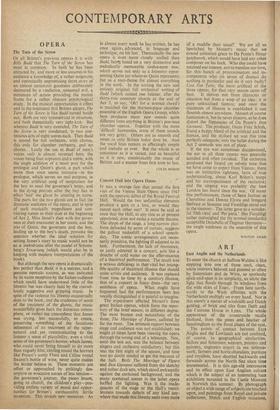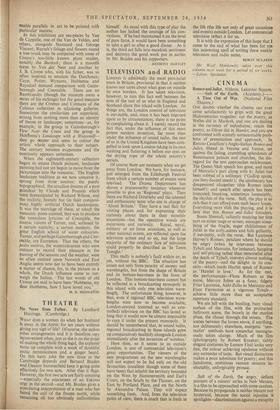ART
East Anglia and the Netherlands To enter the church at Saffron Walden is like stepping into one of those cool, clean, white interiors beloved and painted so often by Saenredam and de Witte, so spotlessly spick-and-span is its simplicity, so white the light that floods through its windows from the wide skies of Essex. From here north- wards to the Wash affinities with the Netherlands multiply on every hand. Nor is this merely a matter of windmills and Dutch gabling, of brick and tiles from Delft and the Customs House in Lynn. The whole appearance of the countryside recalls Holland, from the pines and heather of Sandringham to the flood plains of the east.
The points of contact between East Anglia and the Lowlands arc not confined, of course, to geographical similarities. Sailors and fishermen, weavers, printers and painters, engineers expert in sea defence- work, farmers and horticulturalists, puritans and royalists, have shuttled backwards and forwards across the North Bea since time immemorial. It is this age-old intercourse and its effect upon East Anglian culture which is the subject of an interesting loan exhibition mounted in the Castle Museum in Norwich this summer. By photograph or object a wide range of subjects are touched upon, and paintings from Royal and private collections, Dutch and English museums, enable parallels in art to be pointed with particular success.
In this exhibition are sea-pieces by Van de Cappelle, one of the Van de Veldes, and others, alongside Stannard and George Vincent; Ruysch's foliage and flowers round a tree-trunk may be compared with some of Crome's too-little known plant studies, notably the Burdock; there is a moonlit scene by Van der Neer and another by J. B. Crome who, with his father, was so often inspired to emulate the Dutchman; Cuyp, Potter, Wynants, Hobbema and Ruysdael demand comparison with Gains- borough and Constable. There are no Rembrandts (though the museum owns a series of his etchings) but for good measure there are the Cromes and Cotmans of the Colman collection in adjoining galleries. Sometimes the similarities are superficial, arising from nothing more than an identity of theme or landscape; sometimes—as, for example, in the group in Gainsborough's View Near the Coast and the group in Hobtema's Landscape with a Watermill- they go deeper and seem to colour the artists' whole approach to their subject. The century between evaporates and the continuity appears unbroken.
When the eighteenth-century collectors began to amass Dutch pictures, landscape painting had not yet begun to move from the picturesque into the romantic. The English landscape tradition as we now conceive it, sprang from three sources: the purely topographical, the arcadian dreams of a past grandeur by Claude and Poussin which were domesticated by Richard Wilson, and the realistic, homely but (in their composi- tion) highly artificial Dutch landscapists. It was the marriage of these, at which the romantic poets assisted, that was to produce the tremulous lyricism of Constable, the cosmic visions of Turner, and, softened by a certain rusticity, a certain modesty, the great English school of water colourists. Turner, and perhaps Gainsborough and Con- stable, are European. That the others, the
petits maftres, the watercolourists who were
content to record their pleasure in the passing of the seasons and the weather, were so often centred upon Norwich and East Anglia seems now not to have been entirely a matter of chance, for, in the picture as a whole, the Dutch influence came to out- weigh the Italian. The last words of old Crome are said to have been 'Hobbema, my dear Hobbema, how I have loved you.'
M. H. MIDDLETON



































 Previous page
Previous page